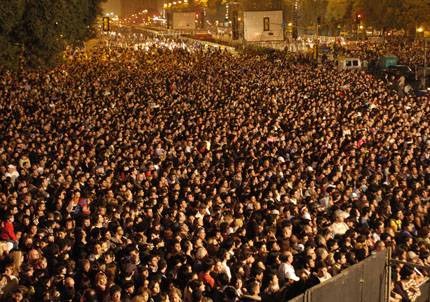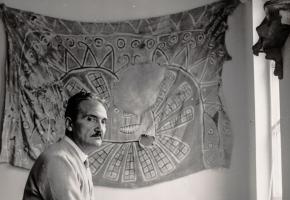Autumn in Buenos Aires, grey and windy, with leaves from the plane trees drifting across the cobbled streets in the suburb of Belgrano where elderly men seek refuge in coffee bars on each street corner. A melancholy city at the best of times, reflected in the lugubrious strains of the tango that invoke the accumulated grief and yearning of an immigrant society. Yet suddenly for four days in May the porteños, as they call themselves, gathered happily in their hundreds of thousands in the central avenues to commemorate the 200th anniversary of an obscure event in Latin American history about which most of their forebears would have known absolutely nothing, for they did not live in the country.
The opportunity for Argentina’s “revolution” of May 25, 1810, was created by Napoleon’s invasion of Spain whose colonies were left in a state of confusion and uncertainty about where their loyalties lay, much as Hitler’s seizure of Paris in 1940 caused alarm within France’s empire. This was not a call for independence, that came later in July 1816, but it was among the first zephyrs of the independence struggle that would engulf the continent for more than a decade. The revolution consisted of the forced resignation of the Spanish viceroy and his replacement by a council of distinguished local figures.
Independence was bad news for the Indians, for the new elites were eventually to exterminate most of them, going on to fill the empty pampas from the Atlantic to the Andes with fresh waves of European immigrants. Yet on the first day of this year’s bicentenary festivities, the Indian survivors of that national tragedy appeared in the central Plaza de Mayo in considerable numbers. They travelled in from the north and south and west of the country to register a note of dissent. They came carrying banners and the wiphala flag, a rainbow creation with seven colours divided into 49 squares that has come to represent the former Inca realms of the Andes, and by extension the new sense of pride in the revival of the continent’s indigenous nations. They advanced in rows in an extraordinary parade, flapping their brown ponchos in unison as though they were wearing skirts in a nightclub, inevitably accompanied by the Andean pipes now unbearably familiar in the tourist zones of European cities.
These were not archaic remnants of an ancient civilisation but modern citizens who smoke cigarettes and take photographs on their mobile phones. Some carried placards saying “Che Vive”. Once abhorred as a Cuban renegade, Guevara has been restored as an Argentine historical hero. One poster had Che accompanied by a top-hatted Tupac Amaru, the martyred 18th century rebel in the Andes, together with a neatly-coiffed woman, the ever youthful Evita Perón. The Indians describe themselves as the “pueblos originarios”, the original peoples of the country, rather as the Americans call their indigenous inhabitants the “First Nations”. They look very different from the typical Argentine settler; they are dark and short and pugnacious. Later that evening their leaders were invited in to the presidential palace, the Casa Rosada, and in a touching and improbable ceremony President Cristina Fernández gave them all a peck on the cheek.
They came with their political demands, the official recognition of their land rights and their separate languages, their complaints about mining and deforestation, yet of course like every other group in Argentine society they are not politically united. Ancient animosities die hard, and the many nations they come from – the Kolle, the Mapuche, the Diaguita, the Lule, the Wichí, the Mocoví, the Guaraní, and several others - have never seen eye to eye. Many saw little to celebrate in the bicentenary celebrations.
Settler Argentina is much the same, divided over the past seventy years into three irreconcilable groups that have taken their turn in power: the military, the Radicals and the Peronists. For the moment, the military and the Radicals are in retreat; the Peronists, loved by some and absolutely loathed by others, are still firmly in control. Juan Perón, military commander and caudillo, came to power 65 years ago and died 36 years ago, yet he remains a crucial reference point for today’s Argentina. Much as foreigners still summon up Charles Dickens when they think of London, so Perón, and the image of populism that he conjures up, continues to exist in the popular imagination in countries far from Latin America. Perón and his wife Evita, now even more lodged in popular memory than her husband, and dead for nearly sixty years, are still evoked as though they were an integral part of the nation itself.
The British and the Americans have never looked benignly on Perón and his populist legacy, in spite of the fact that he modelled his Labour Party on that of Clement Attlee. Maybe his nationalisation of the British-owned (and built) railways was held against him. (In later years they were privatised and closed down.) Maybe the apparent vestiges of Mussolini-style fascism were too much to stomach in the years immediately after world war two. Yet populism, as its name implies, is of course decidedly popular and, as Ernesto Laclau, its chief intellectual proponent, rightly notes, it occurs across the political spectrum. In “On Populist Reason” (Verso, 2005), he deplores the fact that populism of both left and right has always been demoted and denigrated, and continuously faces “a strong element of ethical condemnation”. Some call it “clientelism”, the capacity to buy support and votes through widespread networks of local support. Yet whatever its defects as a political system, it has been springing up again all over the place in the 21st century, once more in Argentina but also in the Venezuela of Hugo Chávez, and the Bolivia of Evo Morales.
One of its characteristics is a revisionist emphasis on the history of the nation and its peoples, especially in evidence in today’s Argentina. Here they are trying to re-examine and revise their past, and to discuss who they really are. The bicentenary celebrations were cleverly used by the present Peronist government to provide a narrative theme, punctuated by significant historical episodes. On the final night of the festivities, an extraordinary pageant was created on a gigantic scale, choreographed by Diqui James, the creative director of Fuerza Bruta, a group of talented artistic entrepreneurs who have been working together internationally under different names for the last twenty years. Using nineteen mobile floats and more than two thousand actors, and with their signature speciality of high wire acts and aerial flight, Fuerza Bruta gave a wonderful, highly politicised version of Argentine history the like of which has never been seen on the streets of Buenos Aires before. With an estimated live audience of two million, plus seven Latin American presidents in attendance (not all of whom stayed the course), the pageant moved slowly through the central avenues of the city.
Among the more striking tableaux was the skeleton of a large steel boat with immigrants on board, dancing to the music of different kinds of European bands. On the ground came groups of tango dancers, with their attendant taxis, recalling their origin in city brothels. Then came a Peronist demonstration from the 1940s, with placards calling for a general strike. One ambitious float depicted the development of national industry, with the famous Siam-Di Tella taxi and the mass production of white goods: domestic refrigerators and cookers. Here the actors as well as the goods on display revolved and moved about on high wires. There was an extraordinary attention to detail and to period costume. Then came the period of the military dictatorship after 1976 which wiped out the experiment with national industrial production. Here there was a display of the famous Mothers of the Plaza de Mayo demonstrating their concern about the fate of their disappeared children. Their familiar white scarves appeared luminous, lit from within, and they paced around under a steady artificial downpour in a riveting display that drew prolonged applause. Next came the conscripts from the Malvinas War of 1982, dressed in dark hoods and capes, and marching like the Mothers through unremitting rain. Suddenly they collapsed on their faces, and white crosses sprang up from their backs. After a brief pause they sprang to life again, with comrades helping each other to their feet. A nice touch.
For Cristina Fernández, the personable president who supervised the festivities, it was an important triumph. She has succeeded in positioning Argentina within the new leftist group of countries that has been changing the face of the continent in the past few years. Lula of Brazil was there in the front row of the stands, as was the charismatic Evo from Bolivia, and Lugo the Paraguayan bishop, and of course the most popular of them all, Hugo Chávez, who was kept busy signing photographs, newspapers, T-shirts, and whatever was thrust towards him. The rhetoric of these presidents may be more radical than their concrete achievements, but the change in mood in unmistakeable. Before the pageant began, Cristina had invited her guests to inaugurate a permanent gallery of pictures of “Latin American patriots” in the Casa Rosada. There was someone for everyone, Simón Bolívar and San Martín and José Martí, of course, but also Evita and Che Guevara and Salvador Allende. The new right-wing Chilean president, Sebastián Pinero, who garnered the votes of many supporters of the late General Pinochet, quickly looked away. The others looked quietly amused.
The portrait of a nation coming to terms with its contentious history was well drawn, but one episode, perhaps the most important event in the 19th century, was missing from the show: the so-called War of the Desert from 1879 to 1892, when a sanguinary general, Julio Roca, later president, embarked on a genocidal campaign against the Indians, making room for fresh generations of immigrants from Europe. One recent news item vividly illustrates the country’s existential problem. Susannah Horn, a teacher in a primary school in the small settlement of General Campos, established by Volga Germans in the province of La Pampa in the 1880s, decided to make her own list of distinguished historical figures for the local schoolchildren to celebrate during the bicentenary. She included General Galtieri, the usually excoriated leader of the junta that embarked on the invasion of the Malvinas, as well as General Roca, the equally criticised author of the 19th genocide. Ms Horn felt that she was entitled to exalt the figure of Galtieri on the grounds that he had bravely fought against the English and “the forces of Nato”; while thanks to Roca’s campaign against the Indians, she said, “us Germans have been able to settle here”. The very name of her village, she explained, was a reminder of Roca’s chief lieutenant, General Manuel Campos, who was personally responsible for clearing the Indians from the area, and enabling a new German population to occupy this region of the pampas. “That’s why we are here”, she said, “the descendants of those Germans”.
Ms Horn was suspended from her teaching activities at the school, and her words were universally condemned, yet her predicament accurately reflects a national reality. However enthusiastic about the “pueblos originarios” the current climate of opinion may be, the fact remains that most Argentines are of settler origin. In the thirty years before the outbreak of the first world war, the country’s population increased from one and a half million to seven million (today it is forty million). Most of the present members of the Argentine congress are children of first or second generation immigrants. Less than ten percent of the population are Indians.
















